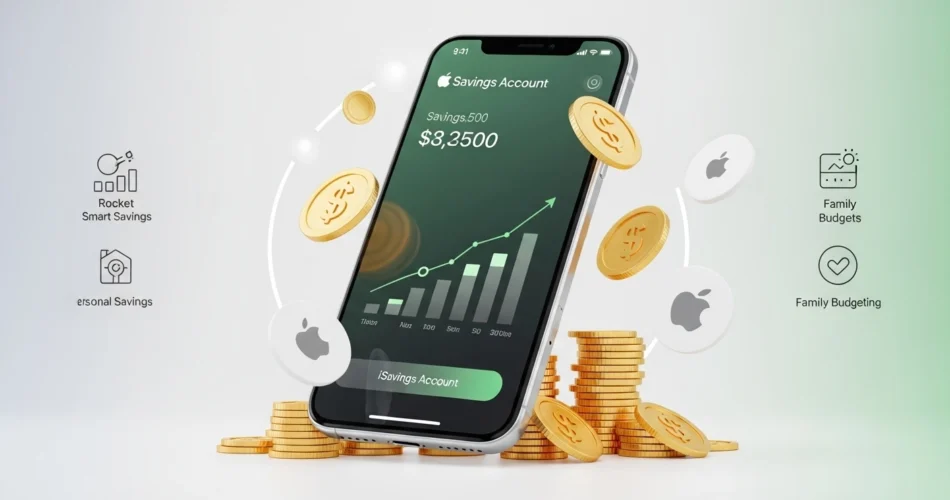The Apple Savings Account is a contemporary savings vehicle built into the Apple ecosystem that solves behavioral friction, improves liquidity management, and accelerates goal attainment for a broad spectrum of savers. This article offers an actionable, research-forward, deep dive into how to leverage an Apple Savings Account for routine saving, house down payments, family finance, capital budgeting style decision making, high net worth financial planning, and scalable automation with tools like Rocket Money Smart Savings and Personal Finance Lab. The approach prescribed here is practical, measurable, and engineered for performance.
Introduction and strategic framing
The Apple Savings Account is more than a branded deposit product. It is a user experience platform that integrates savings psychology, clarity of reporting, and automation at scale. For the next gen saver, the account provides a centralized place to park liquid capital, monitor progress, and automate habit formation. Where legacy savings products relied on in-branch relationships and opaque disclosures, the Apple Savings Account emphasizes transparency and real time engagement. That alone changes behavior.
If your objective is to save for a house, create a family contingency fund, optimize cash flow as a high net worth individual, or apply capital budgeting principles to personal choices, the Apple Savings Account is a tactical enabler. When combined with accelerants such as Rocket Money Smart Savings and simulation environments like Personal Finance Lab, your saving process shifts from manual and emotional to strategic and repeatable.
How the Apple Savings Account changes the saving equation
Visibility is the first lever of savings success. People save what they can see and measure. The Apple Savings Account deposits show up inside a device users consult multiple times per day. That constant visibility nudges consistent contributions. Automation is the second lever. With automated transfers, round up features, and rules-based deposits, saving becomes an autopilot behavior rather than a willpower contest. Security and integrations are the third lever. Where funds are custodied with regulated partners and connected to robust aggregators, users gain both safety and composability.
This threefold combination of visibility, automation, and security makes the Apple Savings Account particularly effective for recurring micro contributions, milestone saving objectives, and emergency reserves. It also integrates cleanly into broader personal finance frameworks that include capital budgeting, tax aware investing, and multigenerational planning.
Using Rocket Money Smart Savings and Personal Finance Lab as force multipliers
Rocket Money Smart Savings provides a pragmatic complement to the Apple Savings Account. Rocket Money Smart Savings focuses on expense optimization, subscription audits, and redirecting discovered savings into dedicated buckets. The logic is simple. If you can identify recurring leakage and automatically reallocate it, you create a low-friction flow of incremental savings that compounds over time. When those reallocated dollars route into an Apple Savings Account, the result is a continuous pipeline to your goals.
Personal Finance Lab introduces scenario modeling and education. Use it to run controlled experiments on contribution schedules, interest rate sensitivity, and event-driven withdrawals. Combining simulation with automation and a transparent savings ledger reduces regret and improves allocation choices. If you want to know whether accelerating your house down payment by 20 percent is sensible relative to an investment in retirement accounts, build the scenario in Personal Finance Lab and then use Rocket Money Smart Savings to operationalize the winning strategy into your Apple Savings Account.
How to open, configure, and optimize your Apple Savings Account
Open the account with intention. Start by setting a primary goal, whether an emergency fund, house down payment, or a family travel fund. Assign a numeric target and a date. Next, setup rules aligned with your cash flow. For example, set an automated contribution that triggers one day after your pay date. If you receive variable income, set a base contribution plus a percentage of surplus receipts.
Once live, create at least two sub buckets or mental allocations. Keep an emergency reserve equal to three to six months of essential expenses. Simultaneously run goal buckets for medium term and near-term objectives. For house buyers, keep the down payment allocation in cash equivalents inside the Apple Savings Account to preserve capital and avoid market volatility in the immediate pre-purchase period.
Optimize by automating micro-savings. Enable round ups, link Rocket Money Smart Savings for discovered savings, and schedule monthly reviews. During the monthly review, reassign windfalls and adjust contribution levels. These small governance steps compound into big outcomes.
How to save for a house using the Apple Savings Account
Define the target precisely. Identify the desired price range, required down payment percentage, estimated closing costs, and a cushion for immediate repairs or upgrades. Once you have an absolute number and a timeline, reverse engineer the monthly contribution required. Automate that contribution inside the Apple Savings Account and set checkpoints at three month intervals.
Use anti fragile rules to protect progress. For example, if market conditions cause interest rate changes or you decide to accelerate salary contributions, map those moves in a scenario in Personal Finance Lab and then adjust your Apple Savings Account transfers accordingly. Keep the target allocation liquid in the months immediately preceding purchase. Preserve capital and avoid sequence of returns risk. Maintain a separate emergency reserve to ensure your house fund is not cannibalized by unexpected expenses.
Tactical acceleration: route bonuses, tax refunds, and side hustle revenue directly to the house bucket. Use Rocket Money Smart Savings to find cost savings in your day to day spending and automate those re routed flows into your Apple Savings Account. Over 24 months, these small inflows can dramatically shorten the journey to your down payment.
Money saving tips for families framed around the Apple Savings Account
Families need structure and systems. Create financial roles inside the household and use the Apple Savings Account as a visual scoreboard. Establish specific buckets for education, healthcare, school supplies, vehicle maintenance, and family vacations. Automate recurring deposits into those buckets so that expense cycles are covered before discretionary spending occurs.
Teach financial responsibility to children through participation. Assign simple tasks and small allowances that are automatically transferred into youth savings buckets. Use the Apple Savings Account as a tool to demonstrate compound growth and goal based motivation.
For practical family savings, deploy high impact tactics: consolidate insurance where discounts apply, audit subscriptions quarterly, plan meals with shopping lists, prioritize preventative home maintenance, and buy used for items with short lifecycle usage. Use Rocket Money Smart Savings to automate the discovery of recurring costs that are easy to reduce and direct those savings into family-specific Apple Savings Account buckets.
Capital budgeting principles adapted to personal finance
Capital budgeting is a corporate discipline for evaluating long term investments. Individuals can adopt the same rigor for major expenditures such as education, a new home, or a business startup. Evaluate each potential use of capital through metrics such as net present value, payback period, and opportunity cost relative to safe alternatives.
When you treat a house purchase as a capital budgeting decision, you calculate expected appreciation, the cost of funds, and carrying costs. Compare these to alternative allocations such as paying down high interest debt or contributing to retirement accounts. Use your Apple Savings Account as the liquidity vehicle for allocations that require safety and quick access. For investments with longer horizons and higher return expectations, consider segregating capital into investment accounts with asset allocation aligned to risk tolerance.
High net worth financial planning and the role of an Apple Savings Account
For high net worth individuals, the Apple Savings Account is not a portfolio centerpiece but it is an efficient treasury management tool. Use it for operational cash, short term liquidity, and immediate spending float. Maintain governance around withdrawal protocols, custodial arrangements, and integration with broader wealth management structures.
Advanced users should implement an internal operating budget, with the Apple Savings Account acting as the clearing account for discretionary spending. Larger, strategic allocations should remain in diversified investments managed by fiduciaries. However, use Rocket Money Smart Savings to detect unnecessary recurring costs even at scale. Small leakages multiply across higher balances.
A strategic flow: use Apple Savings Account for near term goals, cash buffers, and automation while leaving long term capital growth to diversified investment sleeves.
The psychology of saving: why the Apple Savings Account yields better adherence
Behavioral economics teaches that small frictions kill lofty intentions. The Apple Savings Account removes multiple frictions: visibility, friction in transfers, and complexity of tracking. The result is better adherence to plans. Habit formation happens with small wins, and periodic notifications of progress create positive reinforcement loops.
Align incentives with micro rewards. Celebrate milestone achievements and use the Apple Savings Account’s visibility to show progress. Combine this with family gamification by setting shared goals and public progress updates within the household.
The 250 money saving tips condensed into actionable categories
Rather than list 250 items verbatim, treat the 250 money saving tips as a taxonomy of tactics across income, spending, consumption, maintenance, taxes, and mindset. Begin with the highest impact items and cascade into more granular optimizations.
Start with high yield priorities such as automating savings contributions, maximizing tax advantaged accounts, reducing high interest debt, and optimizing insurance coverage. Next, attack regular spending categories: groceries, utilities, transport, and subscriptions. Use price comparison, bulk purchasing, and preventative maintenance to reduce long term costs. For families, prioritize durable goods and resale strategies. For travel and leisure, shift to off peak planning and loyalty optimization.
Finally, invest in personal capacity improvements that reduce lifetime expenses: basic home maintenance skills, automotive preventative care, and cooking skills reduce reliance on higher cost alternatives.
Practical implementation plan using keywords such as Rocket Money Smart Savings, Personal Finance Lab, and next gen personal finance
Practical implementation plan using keywords such as Rocket Money Smart Savings, Personal Finance Lab, and next gen personal finance
Phase one: baseline. Connect all accounts and run a 90 day audit. Use Rocket Money Smart Savings to discover recurring fees and create rules to reallocate that leakage into an Apple Savings Account.
Phase two: structure. Set explicit buckets, automation rules, and a monthly governance meeting. Use Personal Finance Lab to model scenarios such as an accelerated down payment plan or an increased emergency fund target.
Phase three: scale. Introduce secondary goals, integrate family roles, and optimize tax efficient accounts. For high net worth individuals, define liquidity trays and governance protocols.
Phase four: iterate. Review every quarter, adjust automation thresholds, and rerun simulations for any major life change.
The cultural connection using the metaphor of how to save a life and financial resilience
The song how to save a life contains lyrical themes about intervention and prevention. Translate that metaphor into finance to discuss prevention through emergency funds and intervention through liquidity. When you ask how to save a life in a metaphorical financial sense, the answer often begins with building buffers, community supports, and predictable routines. Use the Apple Savings Account to create both immediate buffers and disciplined savings routines that prevent financial crises from escalating.
Conclusion and executive takeaway
The Apple Savings Account is a high utility product for modern savers. It reduces behavioral friction and acts as a tactical hub for short term goals, family planning, and liquidity management for high net worth users. When combined with Rocket Money Smart Savings and Personal Finance Lab, the account becomes part of a disciplined system that delivers measurable outcomes. Apply capital budgeting style thinking to large financial choices, use the Apple Savings Account for safe liquid allocations, and treat automation as the operational backbone of your saving plan.



